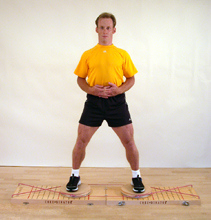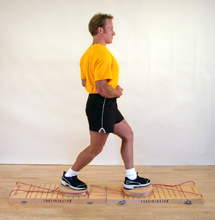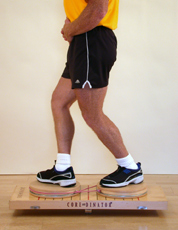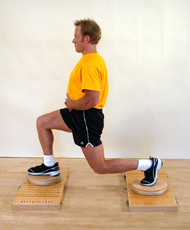

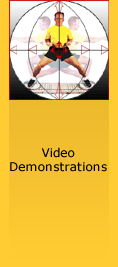
|
L.I.S.T.
BALANCE SYSTEM - Building Blocks
Consider the child learning to stand and walk. As the child moves towards vertical, he struggles with balance. Eventually he rights himself and begins to feel a deeper connection with the gravitational force of the earth’s core. As he attempts the more complex function of walking, he learns through repetition to align an elevated and moving center of gravity, and walking eventually becomes second nature. Similarly, the L.I.S.T. Balance System enhances awareness of our connection to gravity and improves our ability to function.
Breathing is the central mechanism of power and timing, due to the relationship between the respiratory apparatus, core muscles and those muscles related to the spine. Proper breathing technique is critical for optimal performance. It is amazing how many people, including highly skilled athletes, take for granted the breathing mechanism and its role in performance. Developing this mechanism in relationship to movement is accomplished by integrating proper breathing techniques into the training regimen. Each movement has its own breathing requirements, dependent on exertion levels. Without a finely tuned respiratory system, you will never reach your potential as an athlete, always a step behind… a split second late. The solution is simple: unlock your body’s potential by learning how to breathe.
If
you can’t do the time don’t do the crime. As important as exercise frequency and intensity are to a training system, so too is rest and regeneration. “For every up there is a down.” This is the natural law. It is echoed in all of the exercise disciplines that have withstood the test of time. Your mood, state of being, and energy level can all be directly connected to how well you manage your ups and downs. Proper rest and adequate regenerative techniques should be practiced consistently — as routinely as brushing your teeth. The negative effects of stresses imposed by training and everyday life should be neutralized systematically. Your basic rest and regeneration plan should include:
Incorporating the above restoration work into your schedule can neutralize the negative effects of super intense training and help maintain an extreme level of fitness for extended periods of time. Top athletes rely on rest and regeneration to help maintain extreme levels of performance for many years. It is not unusual to see professional athletes competing into their late 30’s and early 40’s. For these athletes, rest and regenerative techniques are the key. Their importance becomes apparent to anyone routinely exercising past the age of 35. As a training priority they move to the top of the list with time.
The five simple activation points of L.I.S.T. VCE are the: (1) arches of the feet; (2) perineal area or anterior pelvic floor; (3) belly button; (4) the heart; and (5) top of the head (including: top of the tongue, soft pallet and crown). As age, stress and gravity begin to press down on the body, its VCE mechanisms begin to degrade. For example, arches of the feet flatten, resting muscle tone of the pelvic floor decreases, lower and transverse abdominals begin to fail and the spine begins to compress, changing the alignment of the head shifting it forward and down wreaking havoc on the entire system. L.I.S.T. Vertical Core Extension:
To
illustrate, imagine carrying a small child up or down
a flight of stairs. For most people, this is a fairly
simple task whose familiarity requires very little concentration.
Now let’s make each stair a different height and
depth to destabilize the environment. What happens?
The familiar becomes unfamiliar and the entire dynamic
of the task changes. To perform it effectively, we must:
(1) visually evaluate each step for height, depth and
distance; (2) estimate the amount of physical exertion
required to climb the step; (3) maintain our balance
to ensure the safety of the child; (4) position our
body correctly; and (5) execute the step. This process
will be repeated with each step, in varying degrees
of concentration, depending on the variance of the step
in relation to the one previous.
By developing a more comprehensive understanding of biomechanics, you will improve your training techniques and move with greater efficiency and effectiveness. In all training regimens, joint alignment is critical for performance and the avoidance of injury. In the L.I.S.T. Balance System, joint stability is enhanced by performing exercises on an unstable base of support. During the exercise, any joint that is out of alignment will cause a break in the kinetic chain and either physical discomfort or loss of balance. Stable joint alignment will enable an exercise to be executed through the entire range of motion at its fullest potential. This maintains the kinetic chain and imprints the neuromuscular code of the movement deep into the body’s biomechanical system.
The destabilized environment of the L.I.S.T. Balance System enhances results. The unstable base of support requires significantly greater mental concentration and an expansion of the muscle groups involved in each movement. The L.I.S.T. Balance System produces great results because of the demands placed on the body’s mind and musculature.
In
the L.I.S.T. Balance System this is accomplished through
the addition of balance. Each exercise presents an exciting
combination of balance, movement and load (resistance)
that will challenge your mental and physical abilities.
You will experience firsthand the importance of biomechanics
and neuromuscular coordination. As your balance improves,
you will begin to feel the difference of a fully functioning
neuromuscular system. This is the L.I.S.T. difference.
In everyday life we take these sensory perceptions for granted. For the athlete in training, it is an entirely different scenario: only through intense sensory training can an athlete perform at his or her optimum level of performance. For example, let’s take a look at the sensory perceptions of an athlete taking the final shot in a championship basketball game with one second left in the game. The athlete’s team is down by two points requiring a three-point shot from the arc, or three-point line. First, there is an understanding of the importance of the game. This adds an element of emotional pressure, or stress, to the situation. Second is an awareness of the time remaining in the game creating a sense of urgency. The athlete must take the shot with virtually no time to think. Third, the athlete must be aware of the position of each member of the other team to assess how they are going to defend the shot. Next, the athlete must interpret the distance to the basket. Finally, in the midst of the intensity of cheering and jeering fans, the athlete takes the shot. The athlete’s body must be in near-perfect alignment if the shot is going to be successful from the three-point line. If the athlete’s senses are finely tuned, he or she will evaluate all of these variables correctly and make the basket. If not, the athlete will be left with the memories of a championship lost. It is the refinement and integration of the senses that makes the difference between a good and great athlete, between success and failure.
The skilled athlete, who is highly conditioned, is probably using 80% to 90% of their strong-side potential (i.e., coordination and strength). With continued training, they can improve this strong-side performance to 100%. Their weak side, however, is probably functioning somewhere in the neighborhood of 40% to 50% and represents the greatest potential for overall improvement. Let’s take a look at a simple overhead press. If the dominant arm is performing at 80% and the weak-side arm at 50%, it is obvious that the athlete is nowhere near peak performance. The press is ultimately limited to the strength of the weak-side arm. The same could be said for functional athletics such as throwing a baseball. The throwing motion of the strong side will be fluid and natural. On the weak side, however, the same exact function will be uncoordinated and unnatural with greatly diminished performance. While a baseball player may never throw with his off hand, working to develop offhand throwing mechanics will greatly improve strong-side performance as the body moves towards neuromuscular balance. Creating total mind-body fitness demands consistent regular stimulation of both sides of the body with a heightened awareness of the weak side. Bringing the body into functional symmetry will: (1) greatly improve strong-side performance as the body moves towards neuromuscular balance; (2) dramatically improve total body coordination; (3) improve balance; and (4) reduce the likelihood of injury. Training the weak side to move towards neuromuscular equality with the dominant side represents the greatest potential for physical improvement and performance.
Copyright 2004 Karl List, All Rights Reserved
|
||||||||||||||||||||||||||||||||||||||||||||||||||||||||
